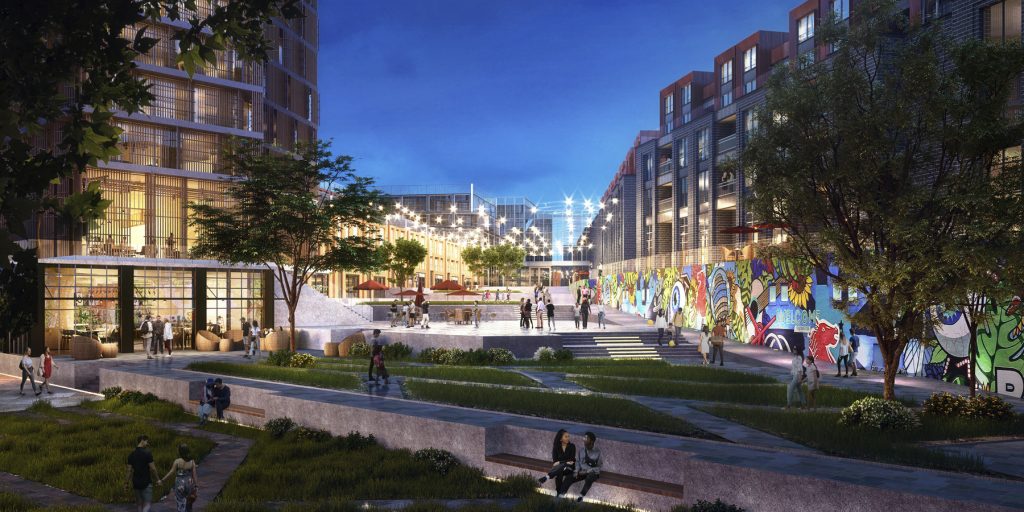Rethinking the ways cities can invest in vital neighborhoods
COVID and the subsequent lockdown have disrupted our daily lives and how we operate as urban dwellers. Collectively and individually, we have become more aware of the assets and resources available within our communities, as well as the areas within our cities that are lacking access to basic amenities.
As we emerge from the pandemic, racial and socioeconomic disparities are more apparent than ever in our urban environments—and we must recenter our focus on creating accessible, equitable cities.
Many cities position themselves as a “city of neighborhoods,” with each neighborhood having its own unique series of characteristics that creates its own identity. A park, distinctive housing stock, restaurants and even topography are just a few physical attributes that can make up a neighborhood’s identity. Demographics such as race, religion and ethnicity speak to the cultural aspects of a community. Both result in real and perceived influences on where people live and are determining factors of where they are willing to move to. Segregation and the racialization of place have contributed to the lack of investment in Black and Latino communities; among other devastating results, there is a complete lack of basic amenities.
There has been a renewed discussion of 20-minute neighborhood as a framework for linking amenities within communities. It is problematic to talk about making balanced, pedestrian-dominated streets with stronger walking routes to cafés when there is a dearth of places to purchase healthy food. It is similarly difficult to talk about making transit and multi-modal mobility more accessible when there is a relative absence of public transportation to begin with.
If we are aiming to create more balanced cities where everyone benefits, we need to examine how we can encourage more investment in our most distressed urban environments to make the 20-minute neighborhood model a reality. When discussing the challenges of underserved communities that suffer from widening wealth and racial gaps, high unemployment rates, lack of proper housing and basic amenities such as grocery stores and recreational spaces, the concept quickly falls apart. In fact, it rings as hollow, and somewhat disconnected from reality.
Too often, disinvestment prevents underserved communities from improving. When investment does happen, gentrification and rising taxes have forced out residents of color who have been in place for generations. In taking a more equitable approach to neighborhood revitalization, we must explore ways that current residents can benefit from change and long overdue investment without being displaced.
For the 20-minute neighborhood concept to be applied through a lens of equity, investment strategies—from both the public and private sector—need to be put in place to attract development to these neighborhoods in ways that current residents can benefit from and participate in. Transportation, housing and technology infrastructure are good jumping off points for a continued evolution toward a more well-rounded neighborhoods.
From a transportation and infrastructure standpoint, the 20-minute neighborhood concept can serve as a vehicle to bring much needed improvements to our streets and public rights-of-way. We have an opportunity to adopt a future-forward approach to continually investing in transportation networks within our communities, ensuring that they better connect residents of these neighborhoods with the rest of the city.
When it comes to housing, history provides many examples of Black and Latino communities being systematically left out and displaced. Exclusionary and restrictive zoning laws and lending practices have historically negatively impacted Black neighborhoods, limiting their access to purchasing or renting homes on certain blocks. While design excellence and the role of the private sector are key, we must encourage our government agencies at all levels to revisit urban policies to allow for better flexibility in residential development and access to fair housing.
And finally, it is critical that we begin to invest in high-speed internet as a public utility, one that is accessible and affordable for households and small businesses. This strategy alone could give much-needed support to Black and Latino-owned small businesses, allowing them to be more competitive as local employers operating within the broader regional economy.
We know that additional investment is required once a strong foundation has been put in place—grocery stores, schools and neighborhood-based health care facilities are among the many things that need attention. These assets don’t necessarily need to be located in every single neighborhood to be effective and supportive. However, they can instead be shared across bordering communities, bringing the neighborhoods together into a polycentric ecosystem of services and amenities that support residents’ livelihoods and well-being.
A city is only as good as its neighborhoods. As the economy continues to recover, we have an opportunity and an obligation to rethink the way we support our cities’ most resilient neighborhoods by exploring realistic ways that we can revitalize communities, create access to basic amenities and attract future investment—setting them up to more adequately support residents and create better pathways for their futures.
Andre Brumfield is a principal and global cities and urban design leader with Gensler.




















